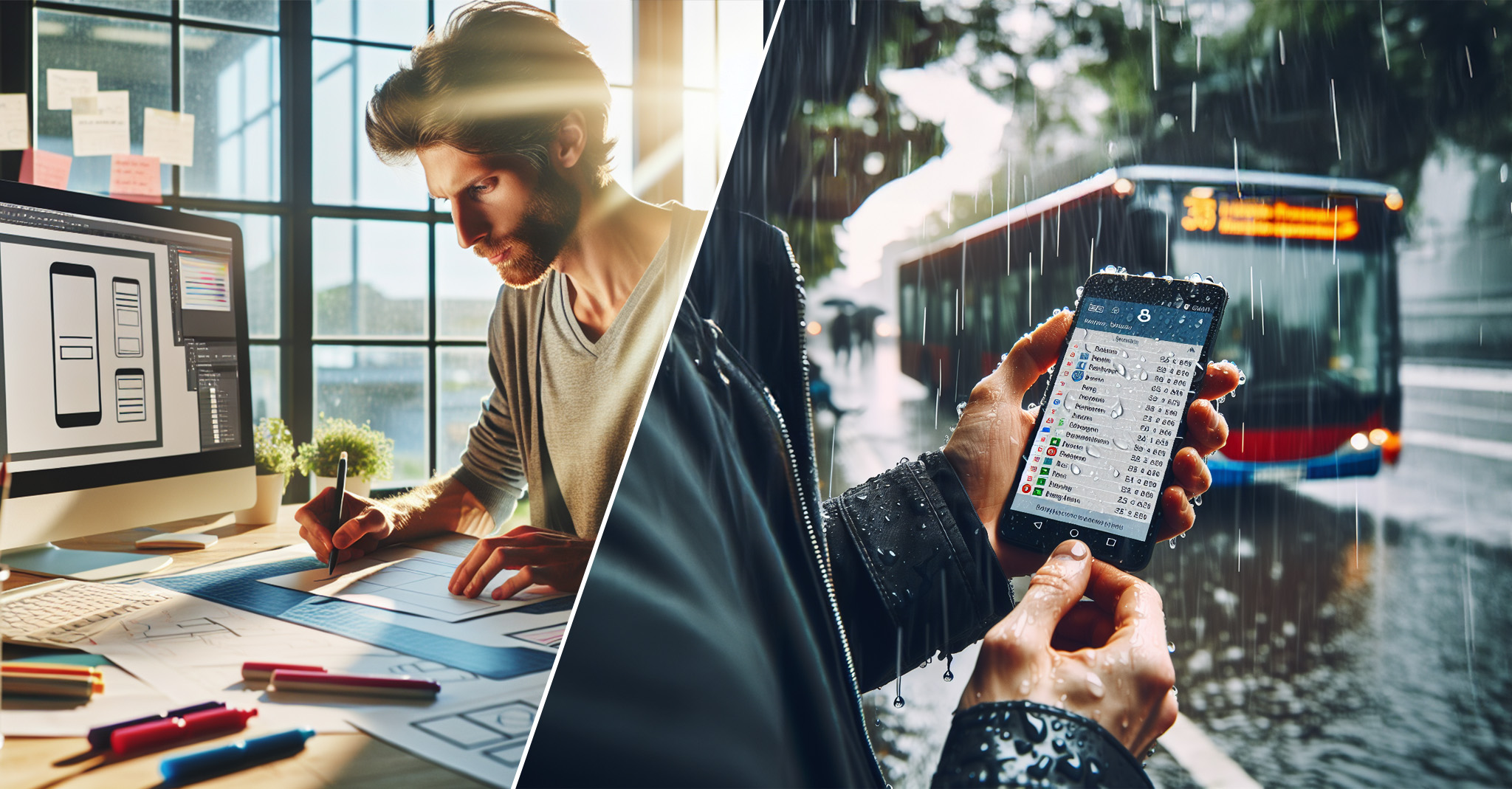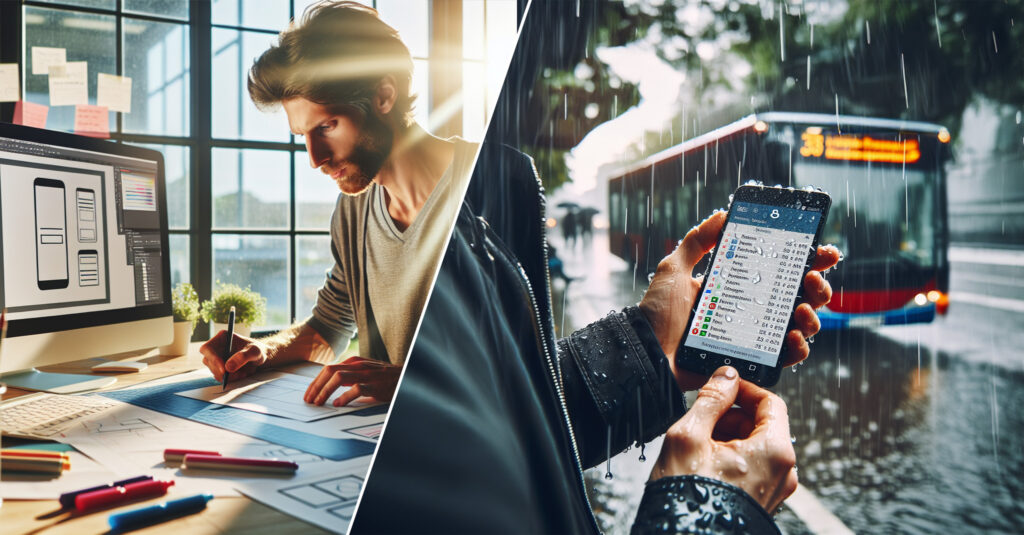- Blog
#Design #ROI #User research #UX
Invest in UX for a better ROI
- 05/06/2024
Reading time 4 minutes

When I was a kid, I had this game I used to play alone when my sister or friends were not around, and I had to keep myself entertained. The game goes like this: Close your eyes and focus. As there’s so many people on this globe, it’s very likely that someone somewhere on the other side of the world is doing the same thing as you are, so focus on that person. When you have made the connection, swap consciousnesses with them so that your mind goes to their body and their mind comes to your body. Now, open your eyes and see the space you are in with completely new eyes, as you have never been here before and everything is new. What do you see? What do you hear, taste and feel? What are the objects around you and what is their function, why are things build as they are, and how does this all guide you to your goals? See the shapes and colors, the main lines and the subtle details.
As a designer and even after so many years I still use this technique today to focus my mind to the person, or nowadays the user, and what they experience. The technique is excellent in helping you to understand others perspective and to see the world with a pair of fresh eyes. When you experience something for the first time, you pay more attention to it compared if it would be something you have seen or experienced before. This is because the human mind always tries to save energy and resources to keep us alive, and after a while stops paying attention to matters which are familiar to us. Thus, it is important that every now and then we bring our mind back to the moment and space at hand.
It’s good to remember that things or processes familiar to us are new to many, and we too once were new to them. How did you feel when you first time used the app or software you now use the most? What was good about it and what things made you baffled, how easy was it to complete a task? How did you feel afterwards – trustful, victorious or subdued?

When you experience something for the first time, it usually is an event you will remember, as so many things in it might be new to you. But also, you might feel there is a wave of new information, making you feel overwhelmed and confused. Your body functions to keep you alive and your mind strives to notice everything, every little detail because to our ancestors it could have been a question of life and death – the mind and body work together to grasp a hold of the situation as fast as possible to define whether it threatens our survival.
In the moment of adapting to new, whether it’s a new environment or a new operating system or a new app, the mind is under a heavy cognitive load and prioritizes staying alive and able to function. Thus, it is smart trying to ease the cognitive load of a user when introducing new features or functions. This can be done by introducing smaller number of new features at a time rather than large, paying attention to the flow and guidance, sticking to styles and flow types which the user is familiar with, and remembering how we as humans process new information. A thing to keep in mind is that people react differently to new experiences and the reactions vary from excitement to terror.
“User experience should not only be a nice-to-have feature but a must-have attribute.”
Easing the cognitive load of a software or an app is important also when thinking about how willingly the user uses the product. Nobody wants to use a product which makes them feel stupid and confused, where interaction efforts are insufficient and completing a task is time-consuming. As pleasant and comprehensive user experience is a megatrend and no product can make it without paying attention to their users, user experience should not only be a nice-to-have feature but a must-have attribute in every product development project. And though we can’t always anticipate all possible scenarios, we should still actively place ourselves into the shoes of the user and pay attention to possible user scenarios. As in everything, seeing things from another person’s view teaches us new perspectives and increases empathy, and in the end helps us deliver better products.
Cognitive accessibility is particularly important when it comes to user engagement and experience. Personally, I measure these factors with something which could be called an irritation factor, which defines the level of irritation the user is under when using the product. In the irritation factor there are both things we can have an influence on and things we can’t but to which we should pay attention to. For example, imagine the following situation: you are waiting for a bus outside, it’s snowing, and your fingers are numb as you try to check the bus schedules from your phone.
The app providing the data has been designed indoors, most likely the designer has been sitting next to a desk in a room with proper lighting and preferable room temperature. Your situation, however, is completely different and you struggle to complete your task as the buttons in the app are too small for your numb fingers and the small texts are hard to read in the poor lighting conditions of the bus stop. The designer couldn’t have changed the weather or the lighting, but they could have considered the app will most likely be used outdoors as busses tend to run outside.
Designing a good product is often a compromise of many things, where good user experience is one of them. Though we can’t always anticipate all possible scenarios, we should still actively place ourselves into the shoes of the user and pay attention to possible user scenarios when designing. As a sum up, as we don’t yet have ways to read each other’s minds (sadly the Vulcan mind meld is not yet possible) we must rely on our imagination and our senses to place ourselves in the shoes of others to see the world from their perspective. Naturally we have various tools to help us understand the user from interviews to workshops, but in my experience, empathy is still the greatest tool you can have.
Our newsletters contain stuff our crew is interested in: the articles we read, Azure news, Zure job opportunities, and so forth.
Please let us know what kind of content you are most interested about. Thank you!